
Grappling is a fighting technique as well as a full-contact combat sport based on throws, trips, sweeps, clinch fighting, ground fighting and submission holds.

Brazilian jiu-jitsu is a self-defence martial art and combat sport based on grappling, ground fighting, and submission holds. BJJ focuses on taking ones opponent down to the ground, gaining a dominant position, and using a number of techniques to force them into submission via joint locks or chokeholds.

A strike is a directed, forceful physical attack with either a part of the human body or with a handheld object, intended to cause blunt or penetrating trauma upon an opponent.
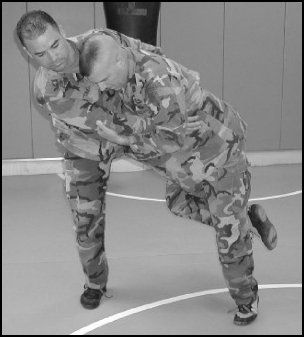
In martial arts and combat sports, a takedown is a technique that involves off-balancing an opponent and bringing them to the ground with the attacker landing on top. The process of quickly advancing on an opponent and attempting a takedown is known as shooting for a takedown, or simply shooting. Takedowns are usually distinguished from throws by amplitude and impact, where the purpose of a throw is to outright eliminate the opponent while purpose of a takedown is to bring the opponent down on the ground, assume a dominant position and then proceed to finish them with jointlocks, chokeholds, or ground and pound.
An armlock in grappling is a single or double joint lock that hyperextends, hyperflexes or hyperrotates the elbow joint or shoulder joint. An armlock that hyper-extends the elbow is known as an armbar, and it includes the traditional armbar, the shoulder triangle armbar, and the shotgun armbar. An armlock that hyper-rotates the arm is known as an armcoil, and includes the americana, kimura, and omaplata. Depending on the joint flexibility of a person, armcoils can either hyper-rotate only the shoulder joint, only the elbow joint, or both the elbow joint and shoulder joint.
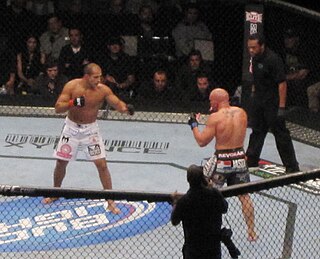
In martial arts and combat sports, stand-up fighting is hand-to-hand combat between opponents in a standing position, as distinguished from ground fighting. Clinch fighting is stand-up grappling. Fighters employ striking, including striking combinations, using either body parts or mêlée weapons, to incapacitate or injure the opponent. Combatants use blocking techniques to block the opponent's attacks.

A knee strike is a strike with the knee, either with the kneecap or the surrounding area. Kneeing is a disallowed practice in many combat sports, especially to the head of a downed opponent. Styles such as kickboxing and several mixed martial arts organizations allow kneeing depending on the positioning of the fighters. Knee strikes are native to the traditional Southeast Asian martial arts and traditional Okinawan martial arts.

Clinch fighting is the part of stand-up fighting where the combatants are grappling in a clinch, typically using clinch holds. Clinching the opponent can be used to eliminate the opponent's effective usage of some kicks, punches, and melee weapons. The clinch can also be used as a medium to switch from stand-up fighting to ground fighting by using takedowns, throws or sweeps.

In wrestling, a bear hug, also known as a bodylock, is a grappling clinch hold and stand-up grappling position where the arms are wrapped around the opponent, either around the opponent's chest, midsection, or thighs, sometimes with one or both of the opponent's arms pinned to the opponent's body. The hands are locked around the opponent and the opponent is held tightly to the chest. The bear hug is a dominant position, with great control over the opponent, and also allows an easy takedown to the back mount position.

A grappling hold, commonly referred to simply as a hold that in Japanese is referred to as katame-waza, is any specific grappling, wrestling, judo, or other martial art grip that is applied to an opponent. Grappling holds are used principally to control the opponent and to advance in points or positioning. The holds may be categorized by their function, such as clinching, pinning, or submission, while others can be classified by their anatomical effect: chokehold, headlock, joint-lock, or compression lock. Multiple categories may be appropriate for some of these holds.
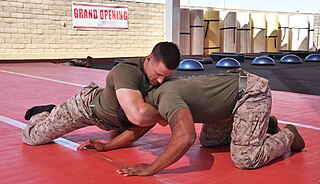
A sprawl is a martial arts and wrestling term for a defensive technique that is done in response to certain takedown attempts, typically double or single leg takedown attempts. The sprawl is performed by scooting the legs backwards, so as to land on the upper back of the opponent attempting the takedown. The resultant position is also known as a sprawl or sprawling position.
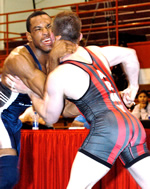
Collar tie is a grappling clinch hold that is used to control the opponent. It is performed from the front of the opponent by grabbing the opponent by the collar, behind the neck, or behind the trapezius muscle. A collar tie using one hand is called a single collar tie, and a collar tie with both hands is called a double collar tie.
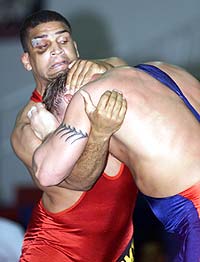
An underhook is a clinch hold that is used in grappling to control the opponent. It is performed from any direction by putting an arm under the opponent's arm, and holding the opponent's midsection or upper body. Having an underhook with one arm is called a single underhook, while having underhooks with both arms is known as double underhooks. The typical response to an underhook is to try to break it, or to establish an overhook.

In wrestling, an overhook, also incorrectly called a wizard, is a clinch hold that is used to control the opponent. An overhook is performed from any direction by putting an arm over the opponent's arm, and encircling the opponent's arm or upper body. Having an overhook with one arm is called a single overhook, while having overhooks with both arms is known as double overhooks. Overhooks are typically employed in response to underhooks by an opponent.

A grappling position refers to the positioning and holds of combatants engaged in grappling. Combatants are said to be in a neutral position if neither is in a more favourable position. If one party has a clear advantage such as in the mount they are said to be in a "dominant position". Conversely, the other party is considered to be in an inferior position, usually called "on the bottom", but in this case sometimes called the "under mount".

A pinch grip tie, or an over-under bodylock, is a clinch hold and stand-up grappling position that is an extension of the over-under position, but having both hands locked behind the opponents back. The hands are typically locked with a palm-to-palm grip, palm-to-wrist grip or fingers-to-fingers grip. The pinch grip tie can be used to throw the opponent, but usually the grapplers attempt to obtain a better hold such as double underhooks or double collar tie. The pinch grip tie is often a neutral position when both grapplers symmetrically have the same hold on each other.

Over–under is a stand-up grappling position in which both combatants have one overhook and one underhook, and is the most common stand-up grappling position in mixed martial arts. The head is typically on the same side as the overhooked arm, to allow greater weight to be put on the opponent's underhooked arm, and hence preventing the opponent from using the underhooked arm effectively. The over–under position can be advanced into a pinch grip tie by locking the hands behind the opponent's back.

Collar-and-elbow wrestling is a style of jacket wrestling native to Ireland. Historically it has also been practised in regions of the world with large Irish diaspora populations, such as the United States and Australia.
Most rule sets for mixed martial arts (MMA) competitions have evolved since the early days of Vale Tudo. As a result of health, legal, and moral concerns, many different rulesets were created, which give different countries and promotions very different tactics and strategies. Similarly, shoot wrestling organizations, such as Shooto, expanded their rulesets to integrate elements of Vale Tudo into their sport. However, for the most part, fighters accustomed to one rule set can easily acclimate to the others.
There are a number of traditional martial arts native to Ireland. The Irish language term for "martial arts" is ealaíona comhraic. Traditional styles include Dornálaíocht (boxing), Coraíocht (wrestling), Speachóireacht (kicking), and Bataireacht (stick-fighting).
















